From Coal Yard to Condos – The History of the Gordon Marine Property on the Gananoque Waterfront
Part One: The Sampson Coal Company
When Gordon Marine closed their gas dock for the final time in September 2013 it marked the end of almost fifty continuous years of marina service from the South Street address in Gananoque. With a proposed condominium apartment project in the works the appearance, and function, of this particular piece of property will certainly change dramatically over the next couple of years.
Prior to the marina operators dispensing gasoline to river boaters during the summer months another type of fuel source, coal, was distributed to local customers from this prime waterfront location. In the early 1900’s The Citizens Coal and Forwarding Company operated a coal supply business from the property. In 1924 Citizens Coal was dissolved and the assets of the company were bought by Walter T. Sampson and his son John. The new company operated under the name of Sampson Coal Company Limited.
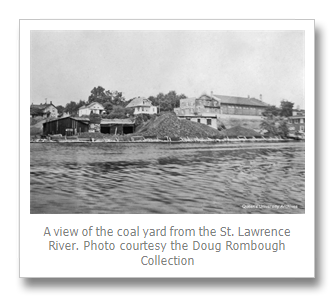
The large wooden coal storage shed and several massive coal piles dominated the view of the property, situated between the Stone Street Dock and the Gananoque Canoe Club, from the river. An old stone building located on the site, formerly a soap factory, was converted into stables by the Sampsons to house the horses that pulled their coal delivery wagons throughout Gananoque. In 1928 the company bought their first motorized delivery truck and soon thereafter the four legged delivery steeds became redundant and were literally put out to pasture.
Lake freighters would bring coal to the storage facility and used large conveyor belts to discharge the dusty, black anthracite onto the heaping stockpiles along the shoreline. Since the primary purpose of the coal sold by Sampsons was for heating it was some of the hardest type available, with a high carbon content, which meant that it burned longer and produced more heat. Delivering boatloads of product to the other coal merchant in town, Shortall Coal Company, was a bit trickier as the large vessels had to navigate up the Gananoque River to off-load. Their passage through the swing bridge at the mouth of the river was always scheduled for night time to minimize disruption to the local road traffic. A newspaper account from 1941 documented the troubles that one steamer encountered while trying to enter the river during low water brought on by a strong east wind. It ran aground just as it was about half way through the open bridge and wasn’t refloated until the wind changed direction and the water level increased enough for the vessel to clear the underwater hazard.
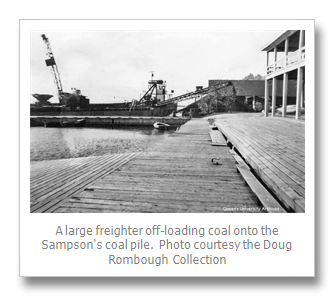
The Sampson Coal Company also had storage sheds adjacent to the Thousand Islands Railway tracks that allowed them to transport loads of coal in rail cars from the Canadian National main line at the Gananoque Junction. The “upper” storage facility was located beside the Gananoque Boat Line parking lot and was across the street from the old Gananoque waterfront station house.
Many residents of Gananoque have interesting recollections of the Sampson Coal Company from bygone years. Paul Scott, the retired publisher of the Gananoque Reporter, remembers the excitement of making the trip to the company’s small office building on South Street each September to pick up the latest advertising ink blotter to use in class at Linklater Public School.
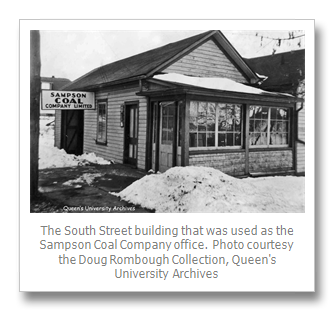
John Nalon, the President of the Gananoque Historical Society, vividly recalls watching the town’s fire brigade battle a stubborn blaze in one of the coal piles at the waterfront. From what he remembers it took a long time to extinguish the fire and the coal pile had to be broken down to find all of the hot spots that were still smoldering. My older sister, Barb, remembers the days when the delivery men would bring coal to our house and put it down the chute into the basement. They would haul the coal from the truck in large two-handled canvas bags that they would sling on their back and carry to the house. This process was repeated until the coal bin in the basement was full. For some reason she was rather indignant when I asked her if she remembered the names of any of the horses!
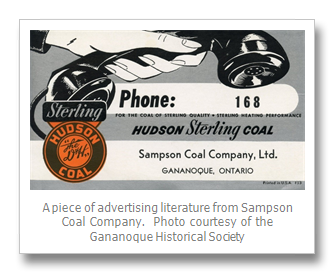
The Sampson family has many interesting historical connections to the Town of Gananoque. Walter T. Sampson was born in Ireland in 1868 and he immigrated to Canada as a young man. He married Pauline Cowan in 1895 and went on to become the President of Ontario Steel Products which had its’ roots in the D. F. Jones & Company and the Gananoque Spring Manufacturing Company. Pauline’s family was involved with the Cowan & Britton Manufacturing Company in Gananoque, whose products included hinges, nails and bolts. Walter and Pauline lived in a beautiful brick residence on the corner of Stone and Sydenham Streets, which is still known as “Sampson House” to this day. They had eight children, three boys and five girls. One son, James McDermot, died as an infant, another, Walter Paul, was killed in action during World War II, and their eldest, John Britton, became the manager of the Sampson Coal Company. Of the girls, Gillian Honor died as a young woman, Shirley Elizabeth married Claude Wright, Ann Patricia married Reginald Rochester, and Grace Mary (Gay) and Bird Joyce Cowan remained unmarried. Walter and Pauline also owned an island in the Admiralty Group, known as Sampson Island or Heritage Island, which my family has had the pleasure of renting for a couple weeks each summer over the past several years.
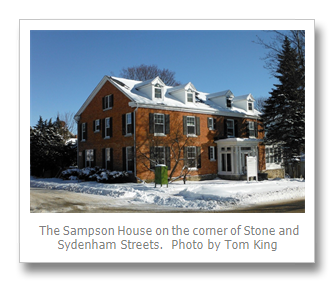
John, or Jack as he was known locally, courted and married an attractive widow, Madeline Ann Forbes, who had recently moved to Gananoque from New Jersey. Madeline had a daughter, Phyllis, from her previous marriage to Charles Forbes, who was six years old at the time of the move. According to Phyllis’s son, Bud Andress, Madeline once owned and operated a hair dressing salon out of the building which later became the Golden Apple Restaurant on the International Square in Gananoque. She and Jack married in 1928.
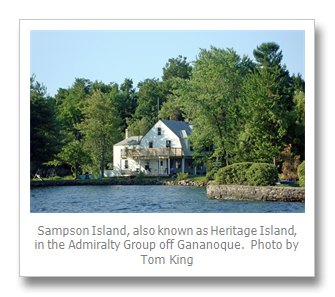
Jack was an avid sportsman and played “third string” football at Trinity College in his youth. This was an impressive feat given that he had suffered from jaundice as a child which left him with a slight speech impediment and a minor physical disability that required extra effort to overcome. Jack was involved in many community groups including The Rotary Club, The Oddfellows and the Friendly Club and he was also active in the Gananoque Canoe Club, The Gananoque Golf Club and was one of the first members of the Gananoque Curling Club. In fact, Don Harding, one of Canada’s most decorated paddlers, remembers Jack driving himself and a group of other paddlers to several regattas in the early 1930’s, “because Jack had a car big enough to fit us all in”.
Like most residents of Gananoque, Jack and Madeline had a love of the river and they owned an island where the family gathered for good times. Gig Island was located east of Leek Island, along the Canadian Middle Channel close to Barge Island and The Punts. Bud, Jack’s step grandson, fondly remembers many trips to the island from Gananoque in the Sampson’s old mahogany hardtop inboard boat named The Swallow. The island was sold to two American families in the mid-sixties and they dredged and dynamited the connecting portion of the H-shaped island to create two separate properties.
In 1964 Sampson Coal Company sold their waterfront property to Gordon Cuttle who had dreams of building a full service marina on the site.
Acknowledgements
I would like to thank the following individuals who assisted in gathering the historical information for this article:
- John Nalon, President of the Gananoque Historical Society, who allowed me access to his files.
- Linda Mainse, Executive Director of the Arthur Child Heritage Museum, who shared her files.
- Doug Rombough, who graciously allowed me to use several photographs from his collection.
- Bud Andress, who shared a lot of Sampson family historical information
- Rick Roberts, Owner of Global Genealogy, who assisted with research on the Sampson family.
- Gananoque Public Library, who provided assistance in accessing microfilms of The Reporter.
- Paul Scott, who shared some personal recollections.
- Don Harding, who shared some personal recollections.
- Barbara Caiger, who shared some personal recollections.
|
Next month: The Cuttle Years.
By Tom King
Tom King and his wife Marion, have lived in Milton, Ontario for the past twenty-five years, where they both worked and raised their family of three children; Kris, Mike and Becca. Tom still has a strong attachment to the Thousand Islands, having grown up in Gananoque and being a “river rat” from a very early age. The family tries to return to the islands every summer and for the past few years have been renting a cottage on Sampson (a.k.a. Heritage) Island, just out from Gananoque.
This is Tom’s 10th TI Life article and Part I of 3 parts to the Sampson property story. Click here to see his past articles.